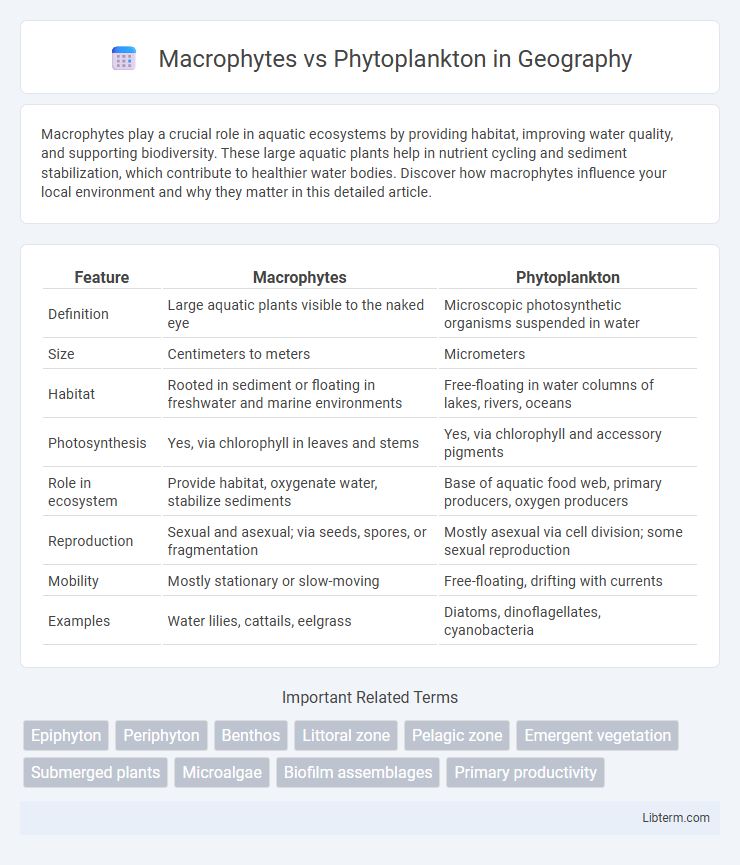Macrophytes play a crucial role in aquatic ecosystems by providing habitat, improving water quality, and supporting biodiversity. These large aquatic plants help in nutrient cycling and sediment stabilization, which contribute to healthier water bodies. Discover how macrophytes influence your local environment and why they matter in this detailed article.
Table of Comparison
| Feature | Macrophytes | Phytoplankton |
|---|---|---|
| Definition | Large aquatic plants visible to the naked eye | Microscopic photosynthetic organisms suspended in water |
| Size | Centimeters to meters | Micrometers |
| Habitat | Rooted in sediment or floating in freshwater and marine environments | Free-floating in water columns of lakes, rivers, oceans |
| Photosynthesis | Yes, via chlorophyll in leaves and stems | Yes, via chlorophyll and accessory pigments |
| Role in ecosystem | Provide habitat, oxygenate water, stabilize sediments | Base of aquatic food web, primary producers, oxygen producers |
| Reproduction | Sexual and asexual; via seeds, spores, or fragmentation | Mostly asexual via cell division; some sexual reproduction |
| Mobility | Mostly stationary or slow-moving | Free-floating, drifting with currents |
| Examples | Water lilies, cattails, eelgrass | Diatoms, dinoflagellates, cyanobacteria |
Introduction to Macrophytes and Phytoplankton
Macrophytes are large aquatic plants visible to the naked eye, such as submerged, floating, or emergent vegetation essential for aquatic ecosystems. Phytoplankton are microscopic, photosynthetic organisms drifting in water columns, forming the base of aquatic food webs and influencing oxygen production. Both play critical roles in nutrient cycling and habitat structure but differ vastly in size, habitat preference, and ecological function.
Defining Macrophytes: Structure and Characteristics
Macrophytes are large aquatic plants that grow in or near water bodies, characterized by their complex structures including stems, leaves, and roots, which differentiate them from microscopic phytoplankton. These plants provide essential habitats and contribute to oxygen production through photosynthesis, with species varying from submerged types like Elodea to emergent forms such as cattails. Macrophytes play a critical role in nutrient cycling and water clarity, often forming the basis of aquatic ecosystems alongside phytoplankton, which are predominantly microscopic algae drifting in the water column.
Understanding Phytoplankton: Types and Features
Phytoplankton, microscopic photosynthetic organisms found in aquatic environments, are classified into several types, including diatoms, dinoflagellates, and cyanobacteria, each distinguished by unique cell structures and pigment compositions. They serve as the foundation of aquatic food webs, contributing significantly to global oxygen production and carbon cycling through photosynthesis. Unlike macrophytes, which are larger aquatic plants, phytoplankton have rapid reproduction rates and adaptability to varying nutrient conditions, playing a crucial role in nutrient cycling and ecosystem productivity.
Ecological Roles: Macrophytes vs Phytoplankton
Macrophytes provide essential habitat structure and substrate for aquatic organisms, enhancing biodiversity and stabilizing sediments in freshwater ecosystems. Phytoplankton serve as primary producers, forming the base of aquatic food webs by converting sunlight into energy through photosynthesis and supplying oxygen to water bodies. Both play crucial ecological roles: macrophytes regulate nutrient cycling and water clarity, while phytoplankton contribute significantly to carbon fixation and energy flow in aquatic systems.
Habitat Preferences and Distribution
Macrophytes predominantly inhabit shallow, nutrient-rich freshwater environments such as lakes, ponds, and slow-moving rivers, where they anchor in sediment and access sufficient sunlight for photosynthesis. Phytoplankton thrive in both freshwater and marine ecosystems, mainly occupying the photic zone of open waters where they remain suspended and utilize available nutrients and light for growth. The distribution of macrophytes is often localized and influenced by substrate type and water depth, whereas phytoplankton distribution is more widespread and driven by water column nutrient availability, light penetration, and seasonal mixing.
Photosynthesis and Nutrient Cycling
Macrophytes and phytoplankton play crucial roles in photosynthesis and nutrient cycling within aquatic ecosystems. Macrophytes, large aquatic plants, enhance oxygen production through extensive photosynthesis and stabilize sediments, facilitating nutrient retention and recycling. Phytoplankton, microscopic photosynthetic organisms, contribute significantly to primary productivity by rapidly assimilating nutrients like nitrogen and phosphorus, thereby driving nutrient cycling and supporting food webs in freshwater and marine environments.
Impact on Water Quality and Clarity
Macrophytes improve water clarity by stabilizing sediments and absorbing excess nutrients, which reduces algal blooms and increases oxygen levels. Phytoplankton, while essential for aquatic food webs, can degrade water quality during blooms by increasing turbidity and depleting oxygen, causing hypoxic conditions. Managing the balance between macrophytes and phytoplankton is crucial for maintaining healthy aquatic ecosystems and clear water bodies.
Responses to Environmental Changes
Macrophytes exhibit slower physiological responses to environmental fluctuations compared to phytoplankton but contribute significantly to habitat structure and nutrient cycling in aquatic ecosystems. Phytoplankton respond rapidly to changes in light, temperature, and nutrient availability, often leading to blooms or crashes that impact water quality and oxygen levels. Shifts in environmental conditions such as eutrophication, temperature rise, or pollution typically alter the balance between macrophytes and phytoplankton, affecting ecosystem stability and trophic interactions.
Importance in Aquatic Food Webs
Macrophytes provide essential habitat and oxygen in aquatic ecosystems, supporting diverse organisms and stabilizing sediments. Phytoplankton serve as the primary producers at the base of aquatic food webs, converting sunlight into energy through photosynthesis. Together, macrophytes and phytoplankton regulate nutrient cycling and sustain the energy flow critical for fish, invertebrates, and higher trophic levels.
Conclusion: Comparative Insights and Future Research
Macrophytes and phytoplankton both play crucial roles in aquatic ecosystems, with macrophytes providing structural habitat and nutrient cycling, while phytoplankton drive primary productivity and form the base of the food web. Comparative studies highlight macrophytes' capacity for stabilizing sediments and improving water clarity contrasted with phytoplankton's rapid response to nutrient availability and susceptibility to bloom events. Future research should focus on integrated ecosystem modeling to elucidate interactions under climate change scenarios, optimizing management strategies for biodiversity conservation and water quality improvement.
Macrophytes Infographic

 libterm.com
libterm.com